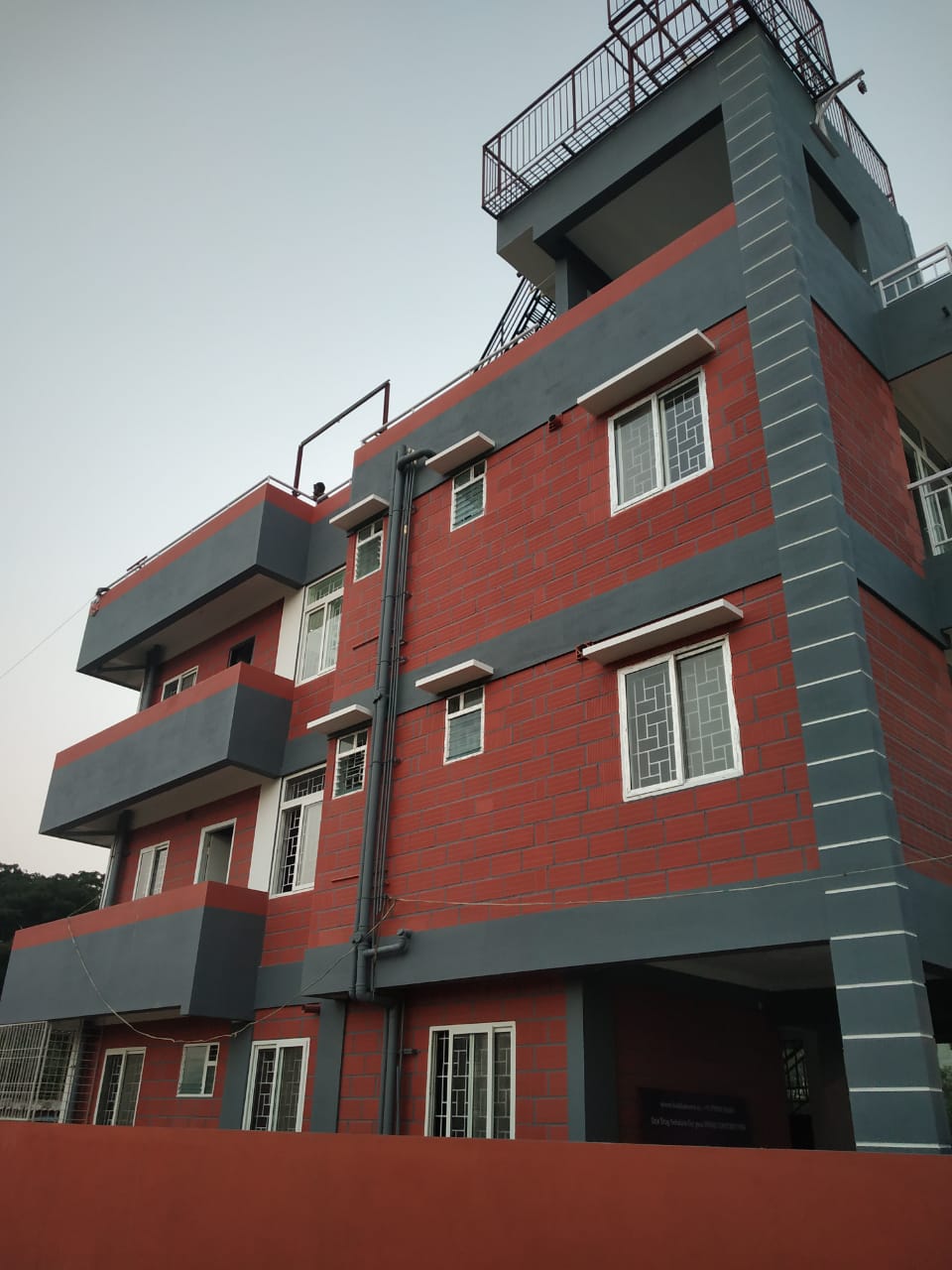When Abhijith R Priyan, the CEO of buildAhome, a Bengaluru-based company delivering turnkey home construction services, started his venture in September 2016, he had one thing on his mind.
(Above image of Abhijith R Priyan on the left and Dr Sunjeev Sivaraman’s residence on the right)
His objective was initially relegated to delivering homes for clients within the timelines set and prices agreed upon, given the prevalence of dishonest contractors or architects who took too much money without delivering on their obligations.
However, barely a year or two into his venture, Abhijith also began to take cognisance of the intense amount of carbon emission left behind by excessive use of steel and cement in constructing homes for his clients, and decided his venture needed a slight change in direction.
“Once I visited a cement manufacturing plant in Bengaluru. Even when I was approaching the plant, I could see the amount of pollution it causes. That got me thinking about whether there is any way we can reduce the amount of steel and cement used to build houses. Another thing that motivated me to start building eco-friendly homes was the cutting of trees for doors, windows, etc. For a 3,000 square foot house, you would at least have two large trees chopped off. I was raised in Bengaluru, which was once called the Garden City, but I see that today, it suffers from extensive tree loss cover. That was my greatest motivation to get into building sustainable houses, while not making them really expensive,” Abhijith tells The Better India.
So far, the company has built about 400 homes across Karnataka and Tamil Nadu, which includes the eco-friendly or sustainable ones. His venture began building their first such home for a London-based client in Mangaluru, Karnataka, in 2018 called Urvi.
The first thing Abhijith and his team of architects and engineers behind Urvi did was replace cement blocks with Porotherm—a hollow block walling system made of clay which is just as efficient as a standard brick. These Porotherm blocks are horizontally or vertically perforated clay blocks. They are made up of natural clay, coal ash, rice husk, and granite slurry and called Porotherm because of their thermal insulation characteristics.
The perforation of the block provides an exceptional walling system which facilitates thermal insulation, resulting in cooler interiors in hot seasons and warm interior conditions in cold seasons. Therefore porotherm blocks are easy to use, economical, and environmentally friendly. Meanwhile, the clay used is often sourced from desilting of dead water tanks and only natural additives like coal ash, rice husk and saw dust are used to make these blocks.
For the doors and windows, Abhijith and his team used reclaimed wood from demolished houses. Not a single tree was cut to build this home and they used about 55% less cement and 35% less steel than they would otherwise use to build a conventional home.

Building an Eco-Friendly Home
Witnessing projects like Urvi and others, Dr Sunjeev Sivaraman, a dentist from Kerala living in Bengaluru, decided to approach buildAhome last year for a home where he and his brother could reside. Over the course of 14 months (including a three month delay because of COVID-19), the company built their three-storey eco-friendly home with a total built-up area of 4,500 square feet in the Jalahalli area of the city, costing Rs 70 lakh.
Similar to Urvi, Abhijith and his team decided to employ Porotherm blocks here as well. But how does it offer greater insulation than conventional building materials?
As the name suggests, it’s porous. All the eco-friendly and sustainable aspects of this house are very elementary. Porotherm blocks work on the simple concept that it takes vacuum more time to heat up than solid material. On the exterior walls, buildAhome used an eight-inch porotherm block, which comes with three perforations. From say 8 am to 5 pm (nine hours), the outer surface of the block heats up, which in turn heats the vacuum, and this happens about three times. By the time that heat enters the house or gets dissipated into the room temperature, it’s already evening when the external temperature is already cooling the surface of the outside blocks.
“That’s how we’re able to maintain ambient temperature inside the house. Once you live in a house where the walls are made of porotherm blocks, you definitely do not need an AC during the summer or a heater during the winter in cities like Bengaluru and Mangaluru,” explains Abhijith.
Of course, the maintenance of ambient temperature is not just the result of using Porotherm blocks. The whole design plays a role in maintaining the ambient temperature inside the house. “In a place like Bengaluru, you wouldn’t even need a fan. During summers, the ambient temperature in the house would be around 25 to 26 degrees Celsius,” he adds.
What’s more, the Porotherm walls are left exposed without plastering externally. This move saves home owners a lot of cement and sand. However, this is a process that requires very intrinsic work that only experts can undertake, and shouldn’t be done otherwise.
Abhijith’s venture sources their porotherm blocks directly from a company called Wienerberger, a German company, which manufactures these bricks in India as well in Kunigal, which is about 70 km from Bengaluru. They have another manufacturing unit in Tamil Nadu as well.
In addition, Porotherm blocks are 60% lighter than conventional walling material, which allows for significant savings on structural cost and faster speed of construction. These blocks also have high compressive strength and a “long shelf life”.
Going Vernacular
Another significant material used in the construction of Dr Sunjeev’s house are Athangudi tiles. These are eco-friendly handmade floor tiles manufactured from locally available materials such as sand, cement and naturally occurring oxides. It’s naturally coloured and sun dried for about 45 days and used directly at the site unlike their machine compressed versions.
“We source these handmade tiles from a vendor called Manjunatha Flooring near Bengaluru. So far, we have sourced tiles for about seven projects from there. They have been giving us a lot of designs and customisations also. When you visit their yard, there are samples kept. They let us customise in terms of colour as well. During the selection of these tiles, we take our clients to the yard itself. We show them how these tiles are manufactured. So, if somebody comes to your house and asks about it, you should be able to answer them,” says architect Ashika Salian, who has been with buildAhome designing eco-friendly homes for over three years.
These tiles get their polish and shine over a period of time. As soon as you lay them, they may not show up very well, but in a year or two, the tiles develop a nicer aesthetic.
“For maintenance, you have to mop the floor with a drop of coconut oil for over a year, just so that it enriches the shine of the tile. In terms of cost, the Athangudi tiles are very economical. They come to a range between Rs 55 and 70 per square feet. If you go for conventional vitrified tiles, it costs about Rs 90 to Rs 100 per square feet. Finally, these tiles create a very homely and earthy feel to your structure. Athangudi tiles also provide employment for locally settled people leaning towards vernacular architecture and using locally available materials in that particular area,” explains Ashika.
Besides Porotherm blocks, buildAhome has also used Jaali blocks for screening purposes. Jaali is the term for a perforated or latticed screen, usually with an ornamental pattern constructed through the use of calligraphy and geometry.
A Jaali wall also saves materials and increases the speed of construction. “When there is no absolute necessity for solid walls, using a jaali wall gives added advantages. It’s a decorative, yet functional block providing excellent protection from the sun’s heat and glare, at the same time allowing a welcoming breeze to pass through,” says Abhijith.
Going further, the venture has employed wide openings, ceiling punctures and skylights in the house to promote better light and cross ventilation, which in turn reduces the usage of power. Of course, no eco-friendly home is complete without a rainwater harvesting tank and recharge pit. At Dr Sunjeev’s home, this system saves about 40,000 litres of water every year, while also assisting in increasing the ground water level, which the rest of the city is struggling to maintain.
Another thing that the venture has done to improve thermal insulation and reduce the use of concrete in the slab is use filler material in the ceiling. When you lay a concrete slab, there is no light that comes in from the roof directly.
“Going back 30-40 years, when we built homes in villages, you had sloped roofs with wooden beams. Instead of normal tiles, you would see glass that was kept so that there is some light that seeps in. But since the advent of concrete and steel that practice has vanished. In the roof concrete itself, we try to keep openings like PVC or glass blocks, which will allow for light to come into the living room or bedroom and you can shape it in the pattern you want. It also enhances the aesthetics of the house,” he adds.
“Finally, we’ve done laminated wooden flooring here, which is made of WPC (wood polymer composite). WPC is made of residue of existing plywood or agriculture waste, which is termite-friendly and weather-friendly. Normal wood compresses, but in these WPC or UPVC sections (for windows), there are no such maintenance issues. The only sort of maintenance issue you would have with this is some skirting damage five or six years later, but it’s as good as any sort of flooring. These also have better sound proof qualities when compared to wood,” says Ashika.

To use or not to use concrete
Is it a practical or viable option to build a home with zero cement? Abhijith doesn’t believe so, calling it a ‘necessary evil’. However, he does agree that it can be used minimally.
“Where cement features in this home is for the joints between the porotherm blocks or other eco-friendly blocks, but for things like flooring, you will have a minimalistic requirement of cement. It’s not necessary that cement needs to be a negative thing. At this point, we can build a house which uses no cement at all, but it wouldn’t be practical for the simplest thing like your roof mould, that has to be made of cement. In other words, it’s necessary, but we can totally minimise its use in construction,” he concludes.
(For more information, you can visit their website or write to them at buildwithus@buildahome.in).
(Edited by Divya Sethu)
No comments:
Post a Comment